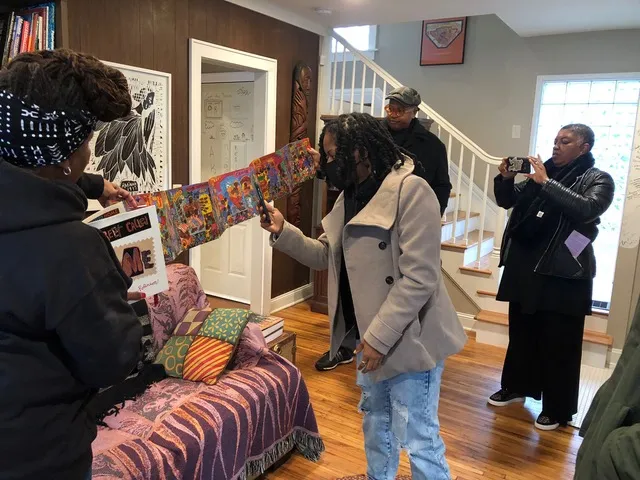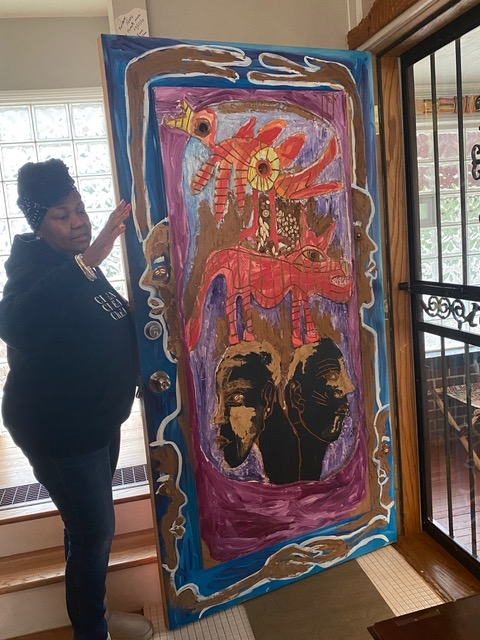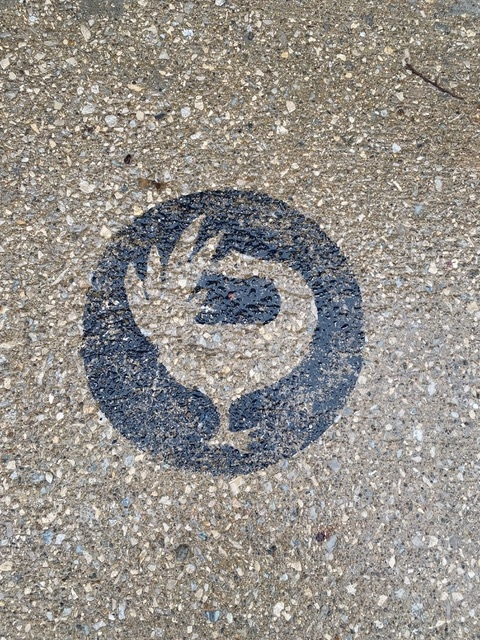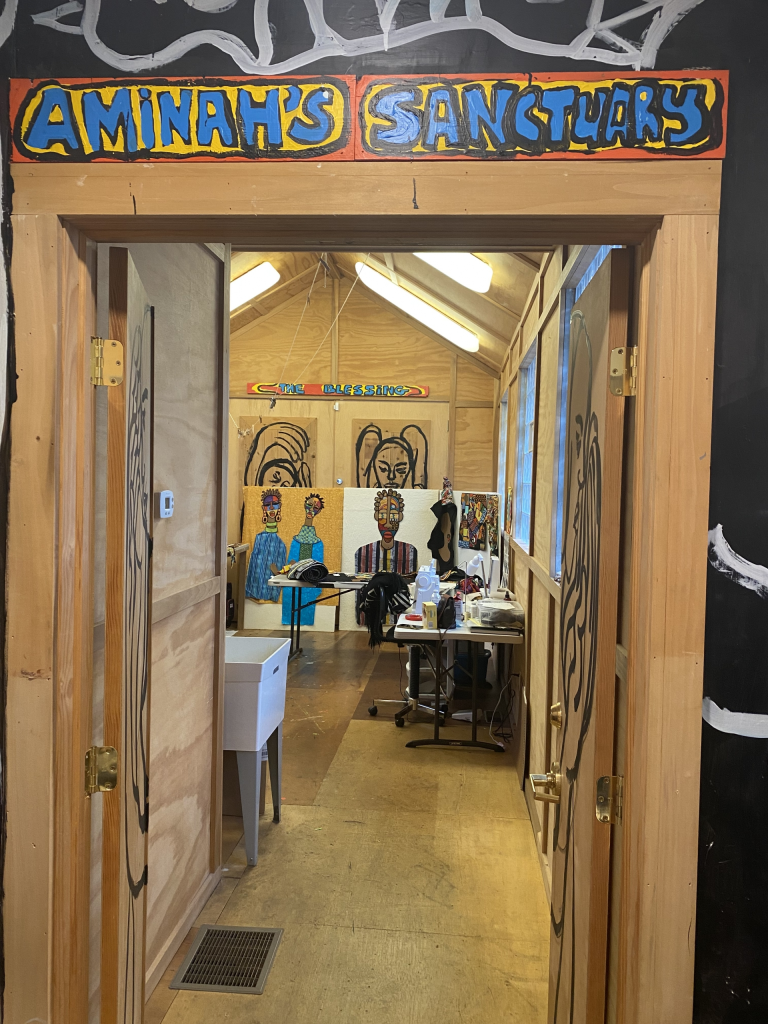“When the house creaks or makes some weird sound, I just say ‘Hey, Ms. Aminah.’ I figure she’s just tipping through to see what I’m working on.”

I smiled when Wendy Kendrick, the 2021 Aminah Brenda Lynn Robinson Fellowship recipient, said that. The fellowship includes a three-month residency in Ms. Aminah’s artful home. Artful is no exaggeration either, as everything from the doors to the cabinets and even the floors are embellished. After meeting Wendy at the Black Fine Arts Fair of Ohio and discussing her work and the fellowship, she invited the BAIA Squad to the house for a tour.
And from the time we parked the van, I was blown away. Instead of grass, there were bricks and river rocks. On top of those were rusted wagon wheels—one big and one small—bottle trees within a bottle garden, which nudged at her southern roots, and Adinkra symbols painted onto the three concrete slabs leading to the porch steps. The symbol closest to the entrance was the Sankofa, depicting a bird flying forward with its head turned backwards, ever reminding us to learn from our past, to go back and fetch the lessons and stories of our elders and ancestors and bring them with us into our present and future. An historical marker stands just outside the front gate, letting passersby know who Ms. Aminah Robinson was, as both an artist and an active member of her Columbus community. The fully painted double doors, inscribed “Within our lives, our souls sings [sic],” give you a heads up as to what lies behind.
“This is where she created until she passed,” Wendy said of Ms. Aminah’s home. “Everything was fair game for creating on. She utilized the entire house.”

A cot in the foyer, titled “Folktale From Poindexter Village, 1800-1957” is one of the first things you see. “She was always documenting the neighborhood,” Wendy explained, “She grew up in Poindexter, which was one of the early public housing developments in the U.S.” Then you’re met with yet another door, this one painted blue, brown, purple, red, and black with facial profiles, outstretched hands, and creatures resembling a bird and maybe a fox. “She was notorious for doing her doors,” Wendy pointed out. Unfortunately, though, the doors are not original. “The museum took those down. When she passed, she left her estate and home to the Columbus Museum of Art. They replaced the doors with a replica.”
Most artists, even if subconsciously, employ lessons from their parents and grandparents into their art. In a PBS Western Reserve interview, Ms. Aminah shared that her art doesn’t come out of her. “It comes through me,” she said, “from a community, from a family, and from my immediate family who shaped my memory. And I just continue the work.” Both of her parents were artists, and they taught her how to create art without commercial art supplies. So, in lieu of paint, she learned to use berries, dandelion, and even tree bark for pigment. Her mother taught her how to sew and her father taught her the art of “observational penetration,” which is the ability to remember the details of everything and everyone in a space long enough to get back to your sketchpad and recreate it. He also taught her the recipe for hogmawg.

Sculpture by Ms. Aminah created using Hogmawg
Unlike the “hog maw” that I’m familiar with—a pig’s stomach stuffed with potatoes, sausage, cabbage, and spices—hogmawg is a mixture of mud, pig grease, homemade dyes, and grounded up brick that creates a mud-like substance that Ms. Aminah used to create sculptures and even chairs.

Photo Credit: Columbus Dispatch
Seeing this picture of Ms. Aminah in the chair she made, which looks more like a throne, reminds me of my grandmother saying “You gotta sleep in the bed you made.” You have to live with the consequences of your actions. Our figurative beds aren’t only built from mistakes and missteps though, but from all our actions—those we wish to forget as well as those we hope to foster, the intentional and the unintentional. And Ms. Aminah was a very intentional woman. An artist who, like the late blackwomanwriter Audre Lorde, was “deliberate and afraid of nothing.” Unafraid of paint splatters on the floor and notes from friends and family written on the walls lowering the value of her home. Unafraid of people thinking that hogmawg is unsightly and perhaps even gross. Unafraid of being a tall, bald black woman with hoops adorning the tops-to-the-bottoms of her earlobes. Of all of her work being about black people, “and when not directly about black people, from the perspective of a black woman.”
Reflecting on Ms. Aminah’s brazenness takes me back to my conversation with Wendy at the Black Fine Arts Fair, standing in front of her crowd-luring quilt titled “Patience.” Born in Kentucky and raised in Ohio, her parents wanted her to go to Kentucky State to become a teacher. “They were encouraging me to get a job that makes sense,” she said. “They taught me what they knew, and they didn’t know any artists.” Black parents have a history of believing that art is a hobby, not a real job. There’s no ill-intent though. Like Wendy’s folks, they simply want what’s best for their soon-to-be-adults: to not have to struggle. Wendy’s parents also preferred Kentucky State because it was closer to home and where they went to school. Instead, she went over 800 miles away to the private Ivy league, Dartmouth College, to major in art.

“So you rebelled?” I asked her.
“You better believe it,” she said. “And that was the first time I ever broke the reins with my parents.” But staring at “Patience,” a quilt that’s longer than it is wide, centering a black woman with bantu knots, a prominent nose, fluffy lips, and folk-artish jewelry, I couldn’t help but ask if there was some rebellion in her artistic process too.
“It is,” she confirmed, “because most of the people I’m in community with have come from the traditional route of quilting, so I’m still having to plug my ears because traditional quilters often believe that things have to be done a certain way. I’m a back door person though. I’m coming from the opposite direction, and I’m good with it. This is me.”
I’m also a rebel. I was the first in my family to homeschool (then later unschool) my children. I wrote a religious novel that had cussing in it. I quit my university job at 25 years old to write. I turned down a publishing deal to self-publish. I’m used to saying thanks-but-no-thanks to advice that’s meant to protect me from myself, and I’ve learned that if you keep your ears plugged long enough, an angel will cross your path and tell you that you’re doing exactly what you should be doing. And if you keep on keeping on, then some of those same folks who initially disagreed will circle back with approval and maybe even some how-to questions. That’s exactly what happened with Wendy, who didn’t start out as a quilter.
“I started as a collage artist in mixed media, on paper first. Then I went to canvas, primarily because I started bringing fabric into it and then the fabric started getting really heavy.” Wendy told me about meeting Cynthia Lockhart at a show they participated in together. They were both rushing inside with their scissors and thread in hand. After a brief conversation, Cynthia, whose background is fashion design, told Wendy, “Girl, take everything that you’re doing in collage and bring it over to fabric.” That’s exactly what she did. Then, in 2010, Wendy participated in a women’s artist exchange in Tanzania. “What resonated with me was the mix of patterns and what some of the women were wearing. We even got to visit with artists there.” True to Sankofa, Wendy gathered all the stories she’d heard, saw, and felt in East Africa, not far from the birthplace of humanity, and incorporated those stories into her art. “When I came back,” she said, “there was a major shift. I had a show scheduled, but everything had changed for me. The gallerist told me, ‘I don’t think they’re going to get this.’ She wasn’t feeling it, but I didn’t care. I had to get it out.”
What that gallerist didn’t know was that Wendy had not too long ago freed her artistry. After a college professor ridiculed her work, she backed away for more than 10 years. Stuffed her craft so far down inside of her that when she gifted her husband a pastel drawing, he asked her where she got it from. She told him she did it, and he almost didn’t believe her. Stunned, he told her to keep going, but she retreated again. Then she was going through an old portfolio one day and her then seven-year-old daughter’s eyes lit up. “Oh, I like that! Who did that?” she asked.
After her professor’s destructive criticism, Wendy had unknowingly made a vow that she’d leave art in the past. It wasn’t until she went on a women’s retreat with her church that she acknowledged the vow, learned how to break it, and then, one day at a time, began actually breaking it. Easing her way back into the art world, she became a docent for the Columbus Museum of Art for eight years, which is where she first met Ms. Aminah in person. She dabbled in framing for a while and taught art workshops to children. Doing a little here and little there but not too much to bring attention to herself.
One of the perks of working with the museum, however, was being able to take classes at the Columbus College of Art and Design. Starting out with Fundamentals, she got back into the groove of drawing and painting. She shared her experience with the teacher of her oil painting class, who was impressed by her work, and he said “Wendy, the only thing you need is probably just a few basics and you’ll click right back in.” There weren’t many women in the program, not many black people either, and she was the oldest in class. But she was on a mission. After the courses ended, she continued doing collages then fabrics and textiles, and joined a community of creators who shared her enthusiasm for quilting.
Alas…she was free to become the artist she’d been since she was a child.

Freeing yourself is one thing, however, and claiming ownership of that freed self, as Toni Morrison said best, is another. And after ten years of suppressing her artistry, another nearly ten years of operating in the shadows, then finally emerging, practicing, and presenting, and especially after traveling to the motherland, she owned her freedom. This ownership is precisely what made going against the grain okay with her. It’s what the gallerist who feared that the audience wouldn’t understand encountered. So it’s no wonder Wendy didn’t care that someone wasn’t feeling her work and no wonder she was compelled to get it out anyway. At that point, it was beyond the mental and physical. She was being Spirit-led.
Going against the grain paid off for Wendy, just as it did Ms. Aminah. After being awarded the 2004 MacArthur “genius grant,” Ms. Aminah used the money to travel, purchase art supplies, and add a studio to her home. Her work with fabrics oftentimes went on so long that she preferred to call them RagGonNons rather than quilts. They rag on and on, in an effort to “reach the Creator,” some as wide as 60 feet. Whether fabrics, furniture, sculptures, children’s books, or even the tile in her kitchen floor, everything she made reflected two of her deepest values, which were family and community—the community of Columbus, of South America, Italy, Israel, Africa, and everywhere else she planted her feet. She was committed to the art of Sankofa, committed to retelling the stories that had been told to her orally, visually, and spiritually. Her gift made room for herself, her ancestors, and for everyone who encountered her work. After her death in 2015, she continued to make room for other artists to remember, retell, refine, and refocus.

Blessed with the opportunity, Wendy is using the space to, like Ms. Aminah, continue creating pieces that are about black people from the perspective of a black woman. Pieces that incorporate sewing, which her grandmother taught her to do; storytelling, which her mother had excelled at; and vibrant patterns, which her travels inspired in her. Pieces that now have some of her initial critics asking when she’s doing another workshop. Pieces that were, for sure, the catalyst of a full circle moment when she asked her daughter where she’d gotten the ring she was wearing; her daughter said that she’d made it. Pieces that gave me the certainty that Ms. Aminah chose Wendy for this fellowship so that she could be free from interruptions and given the money to get the headshots, sewing machine, and hydraulic table she needed.
Pieces that have Ms. Aminah tipping through the house and peeking over Wendy’s shoulder to see what she’s working on.
